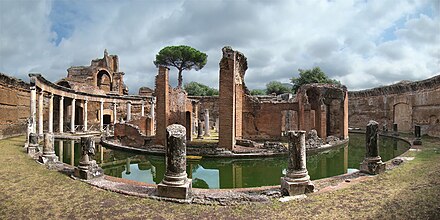Speranza
Villa Adriana
Hadrian's Villa
t
| Villa Adriana (Tivoli) * | |
|---|---|
 | |
| Country | Italy |
| Type | Cultural |
| Criteria | i, ii, iii |
| Reference | 907 |
| Region ** | Europe and North America |
| Inscription history | |
| Inscription | 1999 (23rd Session) |
| * Name as inscribed on World Heritage List ** Region as classified by UNESCO | |
The villa was constructed at Tibur (modern-day Tivoli) as a retreat from Rome for Roman Emperor Hadrian during the second and third decades of the 2nd century AD. Hadrian was said to dislike the palace on the Palatine Hill in Rome, leading to the construction of the retreat. During the later years of his reign, he actually governed the empire from the villa. A large court therefore lived there permanently. The postal service kept it in contact with Rome 18 miles (29 km) away.
After Hadrian, the villa was used by his various successors. During the decline of the Roman Empire the villa fell into disuse and was partially ruined. In the 16th century Cardinal Ippolito II d'Este had much of the marble and statues in Hadrian's villa removed to decorate his own Villa d'Este located nearby.
Hadrian's villa was a complex of over 30 buildings, covering an area of at least 1 square kilometre (c. 250 acres) of which much is still unexcavated. The villa was the greatest Roman example of an Alexandrian garden, recreating a sacred landscape. The complex included palaces, several thermae, theatre, temples, libraries, state rooms and quarters for courtiers, praetorians and slaves.
The Villa shows echoes of many different architectural orders, mostly Greek and Egyptian. Hadrian, a very well travelled emperor, borrowed these designs, such as the caryatids by the Canopus, along with the statues beside them depicting the Egyptian dwarf and fertility god, Bes.
A Greek so-called "Maritime Theatre" exhibits classical ionic style, whereas the domes of the main buildings as well as the corinthian arches of the Canopus and Serapeum show clear Roman architecture.
Hadrian's biography states that areas in the villa were named after places Hadrian saw during his travels. Only a few places mentioned in the biography can be accurately correlated with the present-day ruins.
One of the most striking and best preserved parts of the Villa are a pool and an artificial grotto which were named Canopus and Serapeum, respectively.
Canopus was an Egyptian city where a temple (Serapeum) was dedicated to the god Serapis. However, the architecture is Greek influenced (typical in Roman architecture of the High and Late Empire) as seen in the Corinthian columns and the copies of famous Greek statues that surround the pool. One anecdote involves the Serapeum and its peculiarly-shaped dome. A prominent architect of the day, Apollodorus of Damascus, dismisses Hadrian's designs, comparing the dome on Serapeum to a "pumpkin". The full quote is "Go away and draw your pumpkins. You know nothing about these [architectural] matters." Once Hadrian became emperor, Apollodorus was exiled and later put to death.
An interesting structure in the Villa is the so-called "Maritime Theatre". It consists of a round portico with a barrel vault supported by pillars. Inside the portico was a ring-shaped pool with a central island. During the ancient times the island was connected to the portico by two drawbridges. On the island sits a small Roman house complete with an atrium, a library, a triclinium and small baths. The area was probably used by the emperor as a retreat from the busy life at the court.
The villa utilizes numerous architectural styles and innovations. The area has an extensive network of underground tunnels. The tunnels were mostly used to transport servants and goods from one area to another. The paths and roads above ground were reserved for more high-ranking residents of the Villa. Domes and barrel vaults are used extensively. The domes of the steam baths have circular holes on the apex to allow steam to escape. This is reminiscent of the Pantheon, also built by Hadrian.
In 1998 the remains of what archaeologists claimed to be the monumental tomb of Antinous, or a temple to him, were discovered at the Villa.[1]
[edit] Sculptures and artworks

Theatrical masks of Tragedy and Comedy in refined mosaic, from the villa (Capitoline Museum, Rome)
Artworks found in the Villa include:
- Discobolus
- Dove Basin mosaic, copy of a famous Hellenistic mosaic, Capitoline Museums
- Diana of Versailles, Louvre
- Crouching Venus
- Capitoline Antinous
- Young Centaur and Old Centaur (Capitoline versions)
[edit] Present-day significance
Hadrian's Villa is a UNESCO World Heritage Site and important cultural and archaeological site. It is also a major tourist destination along with the nearby Villa d'Este and the town of Tivoli. The Academy of the villa was placed on the 100 Most Endangered Sites 2006 list of the World Monuments Watch because of the rapid deterioration of the ruins.[edit] See also
[edit] References
- ^ Mari, Zaccaria and Sgalambro, Sergio: The Antinoeion of Hadrian's Villa: Interpretation and Architectural Reconstruction, American Journal of Archaeology, Vol 3, No 1, Jan 2007.
[edit] External links
| Wikimedia Commons has media related to: Villa Adriana |
- Virtual Tour on Lazio's cultural site
- Tivoli - Hadrian's Villa
- Hadrian's Villa near Tivoli, Rome
- Great Buildings: Hadrian's Villa
| ||||
| ||














No comments:
Post a Comment